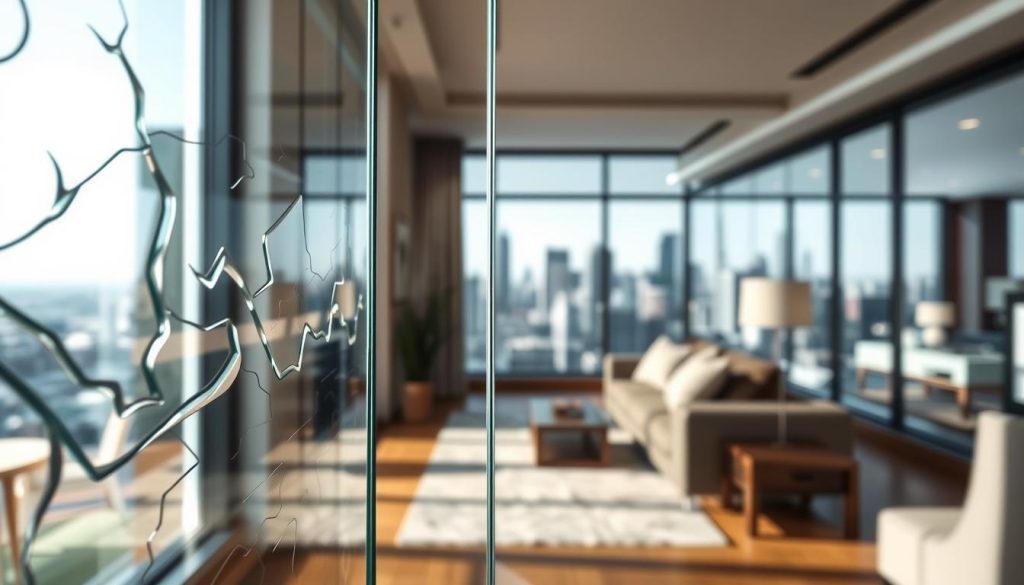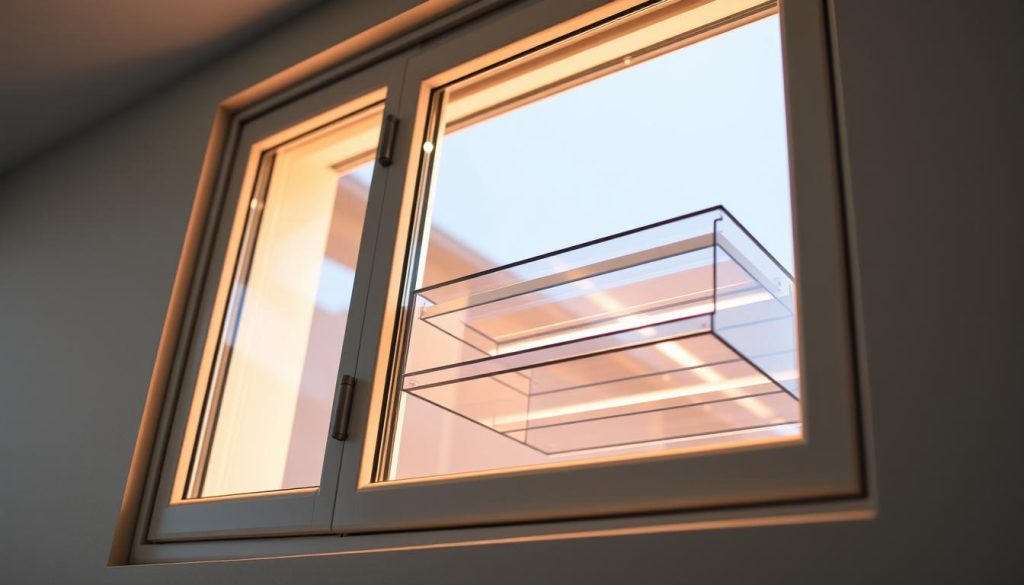Can a single upgrade turn a noisy room into a calm haven and add genuine value to your home?
The rise of urban clatter has many homeowners asking if swapping a pane can really change daily comfort. VELFAC glazing is engineered to cut unwanted urban sound and to improve insulation. A standard double glazed unit reaches an Rw32 rating, which can be boosted to Rw41 by varying glass thickness and the glazing rebate.
By “worthwhile investment” we mean measurable sound reduction, better sleep, higher perceived property value and calmer rooms without losing natural light or air. Performance is shown in decibels via the Rw rating, so you can compare like for like rather than rely on broad claims.
Modern designs often bring thermal benefits too, supporting energy savings alongside quieter interiors. The right solution depends on your local traffic profile, room use and a whole-system approach covering frames, seals and installation. A professional survey matches targets to reality, and most owners notice a clear step-change from day one.
Key Takeaways
- Check Rw ratings to compare sound reduction rather than marketing terms.
- VELFAC double glazing typically ranges from Rw32 to Rw41 depending on build.
- Improved glazing can also boost thermal performance and reduce bills.
- Value rises when frames, seals and installation are included, not just glass.
- Professional surveys match acoustic needs to room use and local traffic.
Noise Cancelling Windows: What They Are and Who They’re For
Specialist glazing and matching doors are built to cut external sound so rooms feel calmer and more private.
What they are: These are specialist window and compatible doors engineered to reduce external intrusion. They combine thicker or laminated glazing, tight seals and robust frames to break sound paths.
Who benefits: City-centre flats, homes beside main roads or rail lines and anyone needing a quiet room for sleep or focused work will see the biggest gain.
Types and options: Choices range from standard acoustic double glazing to advanced systems that allow ventilation when the window is open. For example, Schüco OpenSilent and the AWS 90 AC.SI let fresh air in while still reducing sound.
- Retrofits are possible with the right survey and selection of window type per room.
- Matching doors are advised so one weak link does not undermine whole-house performance.
- Selection depends on dominant frequency — low-frequency traffic needs different glass and frames than higher-frequency voices.
| System | Open performance (dB) | Closed performance (dB) |
|---|---|---|
| AWS 90 AC.SI (Schüco) | 31–34 (Class 2) | Up to 47 (Class 5) |
| Acoustic double glazing | Limited (depends on venting) | Rw32–Rw41 typical |
| Box/composite window | Varies | Can exceed 47 dB in high-spec builds |
Benefits You’ll Notice from Day One
Simple upgrades deliver visible comfort improvements fast.
Expect immediate calm. Conversations feel clearer and traffic hum and wind become less intrusive. Many homeowners report an obvious drop in external disruption on the first night.
Warmth and acoustic gains go hand in hand. VELFAC notes that high-performance units deliver excellent insulation and marked noise reduction. Upgrading to Rw32–Rw41 glass often means less heat loss and lower bills, alongside better interior quiet.
- Improved sleep and concentration in rooms facing busy streets.
- Fewer draughts, which cuts whistling and rattling during windy weather.
- Lower TV or music levels needed, making evenings gentler on the ears.
- Better work-from-home focus thanks to a calmer environment.
Remember: Day-one gains depend on correct specification and a good fit. A well-fitted window often feels quieter than the numbers alone suggest, so choose materials and installation that match your local needs.
How Noise Reduction Glass Works
The secret to quieter rooms lies in layering, mass and clever isolation within the glazing system.
Acoustic interlayers and laminated glass
Laminated glass uses an acoustic interlayer that converts incoming sound energy into small amounts of heat inside the polymer layer.
This reduces transmission through the pane and helps dampen impact and vibration. The result is noticeably lower noise at human hearing ranges.

Asymmetrical panes and varying thickness
Using panes of different thickness targets a wider band of frequencies. Heavier panes add mass; separated layers decouple vibrations.
VELFAC data shows changing thickness and the glazing rebate can raise performance from Rw32 to Rw41, so specification matters.
Spacers, seals and robust frames
Gas-filled cavities, warm-edge spacer bars and tight seals reduce thermal bridging and break vibration paths.
A sturdy frame and multi-point locking clamp seals evenly, cutting gaps that let sound leak. Composite or box window designs add a second sash and an extra air cavity to boost attenuation.
- More mass + decoupling = better reduction.
- System performance depends on glass, frame, spacers, seals and installation.
- Schüco systems show open-position reduction around 31–34 dB and closed performance up to 47 dB in high-spec builds.
Performance Ratings & Classes Explained
Performance ratings translate lab measures into practical expectations, so you can choose a specification that suits your street and lifestyle.
Understanding Rw ratings
Rw is a laboratory measure that shows how many decibels a pane or unit can cut. For example, VELFAC’s standard double-glazed unit sits at Rw32. Specifying thicker glass and an altered glazing rebate can lift that to Rw41 — a clear step up in perceived quiet against road traffic.
Sound reduction classes 1–6
VDI defines classes from 1 (30–34 dB) to 6 (>50 dB). Higher classes suit busy roads or close rail lines; lower classes are fine for quiet streets or back rooms.
“A one-figure rise in dB is often more noticeable than people expect; choices should match your local exposure.”
Open vs closed performance
Some specialist systems still cut sound when tilted or open. Schüco’s AWS 90 AC.SI, for example, reduces by about 31–34 dB when open (class 2) and can reach c.47 dB closed (class 5).
- Practical tip: Bedrooms facing main roads often need class 4–5 closed.
- Remember: installation, frame seals and site context affect real-world results.
When Are Noise Cancelling Windows the Right Choice?
Homes beside busy roads, rail lines or airports commonly benefit from specialist window solutions designed for quieter living.
Common triggers: Dual carriageways, bus routes, late-night town centres and flight paths create persistent noise pollution that affects daily life.
Consider how each room is used. Nurseries and bedrooms need stronger attenuation than a spare room that is seldom occupied.
Chronic exposure to high sound levels harms sleep, concentration and wellbeing. Upgrading a single window or whole elevation can restore rest and focus.
Choosing the right option: Low-frequency traffic rumble often needs heavier, composite or boxed sash builds. Higher-frequency disturbances can be handled by laminated acoustic glass.
- Both homeowners and tenants can benefit; retrofits are usually possible but check conservation permissions.
- If complaints persist or frequencies vary, an acoustic survey pinpoints the best type and specification.
- Where airflow matters, quiet-ventilation systems let you ventilate without losing the sound reduction gains.
| Situation | Recommended approach | Why it helps |
|---|---|---|
| Busy road-facing bedroom | High-mass or composite window with laminated glazing | Improves low-frequency attenuation for better sleep |
| City-centre living room | Laminated acoustic glass + robust seals | Reduces higher-frequency street noise while keeping light |
| Mixed-frequency pollution | Full acoustic survey + phased upgrade | Targets correct glazing type and priorities by room |
Product Options & Glazing Types
A focused specification often outperforms a higher pane count if materials and spacing are chosen correctly.
Double glazed vs triple glazed for high performance
Double glazed units remain common and, when specified well, deliver strong results. VELFAC’s standard double glazed unit sits at Rw32, and by varying pane thickness and the glazing rebate you can lift that to around Rw41.
Triple glazed can help with thermal performance, but acoustic gains depend on pane construction, interlayers and cavity width more than simply adding a third pane.

Laminated acoustic glass and noise reduction glass choices
Laminated acoustic glass uses a polymer interlayer to damp vibrations and target problem frequencies. That makes it ideal for higher-frequency disturbance in living rooms and open-plan spaces.
Designated noise reduction glass comes in tailored variants to tackle low-frequency traffic rumble or mixed exposure. Choose based on an acoustic survey or on-site listening tests.
Box and composite window solutions for very loud environments
Box and composite systems add a secondary sash and a larger air cavity. That extra cavity and separation boost attenuation in very loud settings, and top-end box builds can exceed standard lab numbers such as 47 dB closed on specialist systems.
Front door and sliding door configurations for whole-home results
Doors can be weak links. Match front door and sliding door performance to your chosen window specification so the whole façade performs as a system.
- Prioritise bedrooms and home offices on noisy façades for greatest benefit.
- Use product range options — single-skin, laminated, composite or boxed — to tailor solutions by room.
- Consider maintenance and longevity; a high performance solution should remain effective with simple care.
Windows, Doors and Frames: Building a Complete Soundproof System
Treating glass, frames and doors as one engineered element secures reliable on-site performance.
System thinking matters. A single weak door or poorly set frame will let sound through and undo a high-spec pane. Match door and window performance so one component does not undermine the rest.
Window-door combinations to eliminate weak points
Choose coordinated units for front, side and patio openings. A composite door with laminated glazing should share seals and threshold detail compatible with adjacent windows.
Frame materials, seals, and installation tolerances
Precision in the frame and compression seals stops gaps and vibration bridges. Multi-point locking keeps even pressure on seals and helps maintain the rated result.
- Decouple frames from the structure where possible to cut structure-borne transmission.
- Specify acoustic thresholds to prevent under-door leakage that undermines performance.
- Ensure consistent tolerances so revealing and perimeter sealing meet the manufacturer’s tested detail.
In short: treat glass, frames, seals and fixings as a single soundproof system. On-site sealing and correct ironmongery often determine whether the specified rating is achieved.
Ventilation Without the Noise
Fresh air and calm can coexist when ventilation is engineered to block street intrusion.
Core idea: breathe fresh air while maintaining meaningful sound reduction through engineered airflow paths. Systems such as Schüco OpenSilent and the AWS 90 AC.SI let you ventilate naturally while cutting external intrusion.
Specialist tilt positions use baffles, chambers and lined paths to decouple incoming air from direct sound paths. In practice, the AWS 90 AC.SI achieves around 31–34 dB reduction when open (class 2) and up to 47 dB closed (class 5). Even on tilt, performance approaches that of standard insulating-glass units.
Designing for fresh air with acoustic isolation
Locate vents away from dominant sources where possible and shield openings with architectural features. Secure tilt settings let bedrooms stay cool at night while limiting unwanted sound.
- Use lined chambers and baffles to attenuate incoming sound.
- Place inlet points out of line-of-sight of noisy façades.
- Integrate ventilation with whole-façade acoustic design for best results.
Indoor air quality: thoughtful natural ventilation reduces reliance on mechanical extract and supports healthier indoor air without sacrificing calm. Choose systems proven in busy urban contexts to match expectation with performance.
Measured Results You Can Expect at Home
Lab numbers are useful, but your street, room use and fit determine how quiet your home will feel.
Typical reductions for residential streets vs main roads
Practical benchmarks: a standard VELFAC double-glazed unit sits at Rw32; changing pane thickness and rebate can lift that to Rw41.
VDI mapping shows class 2 suits quieter residential streets, while class 4–5 is recommended near main roads and busy routes.

Setting realistic expectations for different rooms and sizes
Room size and furnishings shape perceived quiet. Soft furniture and curtains absorb reflections and help the ear perceive less intrusion.
A bedroom facing heavy traffic often needs higher-spec or composite/box solutions to tame low-frequency rumble from lorries.
- Moving from old single glazing to Rw32–Rw41 usually gives a noticeable drop in road and voice intrusion.
- Advanced systems such as Schüco AWS 90 AC.SI still reduce by c.31–34 dB when open and up to c.47 dB when closed, so summer ventilation can remain viable.
- Final performance hinges on installation quality and treating adjacent elements like trickle vents and extract fans.
“Post-installation testing is worth the cost for bedrooms and home offices to confirm target reduction has been met.”
| Scenario | Typical target | Why it helps |
|---|---|---|
| Quiet residential street | Class 2 (≈31–34 dB) | Sufficient for daytime comfort and light traffic |
| Main road or rail nearby | Class 4–5 (≈40–47 dB) | Improves sleep and reduces low-frequency intrusion |
| Rooms needing high isolation | Composite/box window or laminated high-mass | Mass and decoupling tackle deep rumble from heavy vehicles |
Noise Pollution Use-Cases: Homes, Studios and Offices
Tailoring glazing and doors to each room’s use brings measurable gains in calm and focus.
Bedrooms and living rooms near busy roads: For front-facing bedrooms a higher-class solution helps sleep. Living rooms that face busy streets benefit from laminated glass and robust seals to reduce evening intrusion.
Home offices: Remote work needs steady concentration and clear calls. Specify units with higher mass and airtight frames so conferences and deadlines are not disrupted.
Studios and specialist rooms
Recording studios, content creators and music practice rooms demand stricter control. A studio often uses composite or box solutions plus sealed doors to form a full acoustic envelope.
- Match glazing class to exposure — class 2 for quiet streets, up to class 5 for main roads and airports.
- Protect hallways and balconies with matched doors so one leaf does not undermine a room’s performance.
- Use tilt-ventilation (e.g. Schüco OpenSilent) to keep bedrooms fresh at night while still limiting street intrusion.
- Supplement high-mass glass with secondary measures such as acoustic curtains or internal baffles for fine tuning.
Professional guidance: For podcasting, mixing or piano practice, a survey and targeted spec will hit precise targets and avoid over- or under-specifying the solution.
Installation Quality and Aftercare
Good specification needs equally good delivery — the rated performance is only achieved on-site when survey, fit and follow-up care align.
Survey, fitting, and sealing to achieve specified performance
An accurate survey captures reveal sizes, wall build-ups and likely transmission paths. This information guides the choice of glass, frame and fixings so the installation meets the specified Rw or class target.
Best-practice fitting uses correct packers, continuous sealant lines and careful attention to thresholds and trickle vents. Multi-point locking compresses gaskets evenly and keeps the frame stable under wind and vibration.
Minor gaps or poorly compressed seals can erode a quoted decibel reduction. Even small leaks around a frame or door will let sound and heat through, so precise detailing matters as much as the pane itself.
Maintenance to preserve acoustic and thermal results
Scheduled checks keep performance steady. Inspect gaskets, hinges and locks annually and re-tension where vibration has caused movement.
- Clean drainage channels and keep weep holes clear to avoid wind whistling.
- Lubricate moving parts and check compression to preserve acoustic integrity.
- Document installed specification and retain warranties for future reference.
Periodic reviews are advisable in high-traffic locations since vibration can loosen fixings over time. Aftercare not only protects sound reduction, it preserves thermal efficiency and the lifetime value of your window and door system.
Design, Shapes and Aesthetics Without Compromise
Contemporary acoustic systems now offer tailored profiles so design need not be sacrificed for performance.
Form and function come together in a wide product range. Manufacturers such as Schüco supply project-specific solutions so a chosen shape or size can match an architect’s intent while still delivering proven reduction.
Slim sightlines and consistent finishes let your windows and doors blend with the façade. That means you keep natural light and clean lines without compromising the tested performance of the unit.
For the front elevation, heritage cues and planning constraints are considered early. Systems accept transoms, mullions and larger panes so you can retain period proportions or a modern, open look.
Hardware choices and colourways help coordinate interiors. Glazing bar effects are selectable to suit style while still meeting thermal and acoustic targets.
- Custom finishes allow matching to existing frames or a new scheme.
- Composite or boxed profiles fit bespoke openings where extra mass is needed.
- Conservation-friendly options balance appearance with measurable performance gains.
Practical tip: request samples and completed project photos to see sightlines, handle choices and glass proportions in real installations. Visual checks help you confirm the aesthetic outcome before finalising the door and window specification.
Pricing, Value and Return on Investment
Understanding cost helps you invest where it counts most.
How specification, size and glazing type affect price
How you specify glass, frames and hardware directly shapes the final price and the resulting value.
Thicker glass, laminated interlayers, composite or box constructions and specialist ironmongery increase material and labour costs. Larger openings and heavy sashes add weight, longer fitting time and higher transport charges.
Balancing budget with performance levels
Focus spending on the noisiest façades for the biggest perceived gain. Upgrading a single bedroom or a main reception room first spreads cost while delivering immediate comfort and energy benefits.
Return on investment often shows as better sleep, improved concentration and lower heating bills thanks to improved thermal performance.
| Driver | Effect on price | Why it matters |
|---|---|---|
| Glass type (laminated/thicker) | Moderate–high | Raises mass and acoustic performance |
| Composite/box system | High | Extra cavity and mass for deep rumble reduction |
| Size & opening type | Varies with weight | Larger panels cost more to produce and fit |
| Warranty & service | Small–moderate | Longer cover adds value and peace of mind |
Practical tips: compare quotes on a like-for-like basis by checking Rw or class numbers rather than headline price. Ask for itemised proposals that show how moving from Rw32 to Rw41 affects cost and benefit. Prioritise warranty length and aftercare so the upfront spend delivers lasting value.
Noise Cancelling Windows
Manufacturers offer tailored systems that combine tested glass, robust frames and precise seals for consistent on-site results.
What this means: a wide range of options is available for UK homes, from Schüco’s AWS 90 AC.SI to box window systems and VELFAC double glazed units rated Rw32 with upgrades to Rw41 by altering glass thickness and the glazing rebate.
Select a high quality supplier who publishes lab data and clear warranties. Confirm tested numbers and ask for UK case studies covering flats, terraced houses and detached sites.
System performance depends on glass, frame and seals working together. Match adjacent doors and the front door to avoid weak links. A curated range helps balance aesthetic aims with practical, soundproof outcomes.
- Shortlist preferred opening styles and finishes before specification.
- Ask for room-by-room advice and an in-home assessment to translate lab figures into real gains.
Choosing the Right Level of Performance for Your Location
Assessing exposure first makes spec decisions simple and effective.
Assess traffic volume and distance to the source, then match that exposure to a target class. Measure cars per hour, note distance in metres and record whether you face a reflective façade. These facts set a clear performance goal.

Mapping traffic levels to sound reduction classes
Practical guidance: aim for class 2–3 on quiet residential streets, class 4–5 for main roads, and class 6 where motorway or very heavy traffic sits close by.
| Situation | Target class (dB) | Why |
|---|---|---|
| Quiet residential street | Class 2–3 (≈31–39) | Suits lower traffic levels and moderate distance |
| Main road (36–300 m) | Class 4–5 (40–49) | Controls higher intrusion for bedrooms and living rooms |
| Motorway or | Class 6 (>50) | High-mass or box solutions needed for deep rumble |
Remember that product reduction differs when a unit is open. For example, Schüco AWS 90 AC.SI gives c.31–34 dB when open (class 2) and up to c.47 dB closed (class 5). Where ventilation is non-negotiable, choose tilt-vent systems rated for on-tilt performance.
Final checks: combine window and door specs for a consistent façade level and consider noise logging or a professional survey for borderline sites or planned future road changes.
Why Choose a High-Quality Supplier in the UK
Picking the right supplier protects your specification and the real-world performance you expect.
A reliable UK manufacturer pairs measurable performance figures with tested systems and aftercare, so you get the rated result on site. Schüco and VELFAC publish Rw and class data that let you compare options objectively before you commit.
Proven performance, compliance and support
- Ask for lab certificates and clear Rw/class numbers rather than marketing claims.
- Check UK certifications, warranties and compliance documents to ensure long-term support.
- Confirm that the supplier offers matched windows doors and door systems so one component does not undermine the whole façade.
Installation, references and aftercare
Choose trained installers audited by the manufacturer. Correct fitting is often the difference between lab figures and on-site results.
Do this before you sign:
- Request UK case studies similar to your setting — main roads, rail lines or airports.
- Ensure parts availability and aftercare commitments for long-term serviceability.
- Ask for a transparent specification that lists glass build-ups, frame types and seals.
“Documented data plus certified installers and clear warranties give the best chance of achieving the published acoustic and thermal targets.”
Practical benefit: a high quality supplier also helps with planning and building control where acoustic performance is required, reducing delays and unexpected costs.
Conclusion
Modern glazing systems can make a substantial difference to daily calm and long-term comfort at home. ,
Well‑specified units deliver clear noise reduction and help reduce noise while improving sleep and focus. VELFAC shows Rw32–Rw41 gains and Schüco OpenSilent gives c.31–34 dB on tilt and up to c.47 dB closed; box builds can do even more.
Combine the right glazing with robust frames, seals and pro installation to get true on‑site results. Choose ventilation‑friendly options so you can air the room without heavy street intrusion or added noise pollution.
Start with the most affected room, then scale across your home. Match targets to your street via class guidance and insist on verified data and UK warranties. Book a tailored survey to define a specification that will reduce noise from day one.



